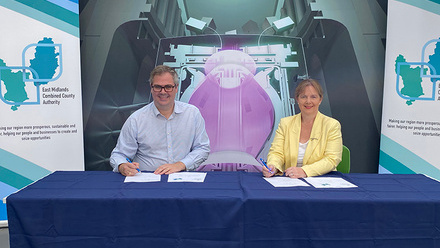Is the UK's energy storage fully charged for the future?
A recent Westminster Forum discussed how the UK can achieve globally competitive energy storage supply chain by 2030.

Edward Keith, Head of Consulting at Rho Motion, advised delegates that the best mechanism for the UK to transition away from fossil fuel consumption – and achieve net-zero – was through the electrification of its energy systems.
But he noted that, while the UK was a 'global leader' on battery storage for the grid, in terms of the supply chain, integrators and system operators will need to take politically sensitive, albeit realistic, decisions on 'working with Chinese cell manufacturers', especially lithium-ion battery suppliers.
He was speaking as part of a Westminster Energy, Environment & Transport Forum policy conference in May, on ‘The next steps for UK energy storage’. The then government’s release of a UK Battery Strategy was the context for much of the discussion.
Keith highlighted that three Chinese firms owned more than 50% of the market for energy storage cell manufacturing, and it would be challenging for the UK to commercially scale up domestic alternatives.
While Nicholas Beatty, Director at Zenobe Energy, argued that it was therefore important to extend battery life in the UK and Europe, because the 'amount of primary manufacture of batteries is really not at the level that we would like to see'.
He pointed to the potential for second and third-life applications to extend the original battery’s operational use.
One of Zenobe Energy’s focuses is fleet electrification. The business operates more than 1,000 electric buses, coaches and trucks throughout the UK and Europe. Beatty explained that most of its batteries typically last up to eight years, but their life could be extended by a further five years in secondary applications. He also said they could be used a third time to support, for example, the energy requirements of cellular towers.
Luke Ames Blackaby, Head of the Innovation Hub at the Office of Gas and Electricity Markets (Ofgem), explained the role of its £450mln Strategic Innovation Fund in transforming gas and electricity networks for a low-carbon future and, in the context of the forum, supporting long-duration energy storage (LDES) deployment.
He added that in an increasingly digitalised and decentralised world, energy networks were becoming more complex and this presented challenges for LDES, including how it could be brought online at scale to capitalise on the massive, anticipated expansion in renewable energy generation.
Balancing mechanism
Multiple challenges have slowed LDES’ rollout, said George Anstey, Senior Managing Director at NERA Economic Consulting.
He highlighted subsidies for competing technologies, such as carbon capture, utilisation and storage, and capacity market rules that require delivery in less than four years.
Also, the National Grid, he said, is 'very reticent' about using batteries in the 'balancing mechanism', because rather than reduce constraints, they have the potential to exacerbate them.
'In essence, if you build a load of batteries in Scotland to soak up very cheap Scottish wind power through the balancing mechanism, and National Grid allowed the batteries to do that, they’d be incentivised to discharge when the national price was high, which might be when there’s still a surplus of power in Scotland,' he warned.
So, until the policy and market frameworks to deliver LDES have been developed, the UK will not see the 'rapid deployment of storage that we need', asserted Anstey.
Blackaby acknowledged that because LDES is a 'relatively new system asset', there might need to be changes to regulation and market frameworks to ensure it meets future requirements.
Alec Whiter, Partner at law firm Burges Salmon, welcomed the UK Department for Energy, Security and Net Zero’s (DESNZ) consultation on Designing a policy framework to enable investment in long duration electricity storage earlier this year. But he urged the government to move faster.
Although there are proposals to introduce a revenue cap and floor regime for the LDES sector, he cited pump-storage developers who have ready-to-build projects that will take multiple years to complete. He stressed this 'policy really needs to come in to unlock that development'.
Whiter also said there was a “balance to be struck” between incentivising the more mature technologies that could deploy quickly, and newer ones such as liquid and compressed air.
Alex Campbell, Director of Policy and Partnerships at the Long Duration Energy Storage Council, outlined the different LDES technologies (see box-out above). He said it was critical to include thermal in the mix, noting that storing renewable electricity in the form of heat would help decarbonise many industrial processes.
When asked about the barriers to thermal storage, he said the main one was grid fees. 'The grid will treat you as if you will be using it at peak time and then charge you accordingly, which can be prohibitive, especially compared to gas,' he explained.
Location, location, location
The location of these storage projects is also a hot topic. Paul Nathanail, Specialist in Land Condition at Land Quality Management, acknowledged frustrations over planning committees refusing development.
He told the audience that unless a developer could 'credibly and reasonably' make a case that its proposed storage project constituted sustainable development under the National Planning Policy Framework, the application would most likely fail.
'There is a presumption in favour of sustainable development which spans the environment, economic and social dimensions,' he explained. 'Applications need to give equal emphasis [to all three] if they want to credibly benefit from that presumption.'
Sarah Griffiths, Vice President of Government and Regulatory Affairs at Hydrostor, highlighted the developer’s two, compressed air, energy-storage projects in California, USA, and New South Wales, Australia. They are both built in hard-rock caverns.
Griffiths explained, 'When power is needed…a valve is opened, water pushes into the cavern, pushes the air up, goes through the heat exchangers, turns the turbines and produces electricity. What makes this different…is the removal of the fossil fuel element on a traditional compressed air plant.'
Turning to the UK, Griffiths urged the government to set targets and/or mandates and then ensure the right financing tools existed.
'If designed properly, the proposed cap and floor scheme, as well as the optimised capacity market through the Review of Electricity Market Arrangements, can be the right tools for LDES in the UK,' she argued.
She went on to say that DESNZ had previously confirmed in a parliamentary committee that it recognises the need for eight-hours-plus energy storage.
However, she advised the department to recognise there are 'commercially available technologies that are cost-comparable to pumped hydro technologies, with flexible siting that can be located where the grid needs it', and that can also meet the UK’s energy needs through to the 2030s.
Max Carcas, Strategic Director at SynchroStor, noted how a £9.4mln DESNZ contract allowed the firm to develop a megawatt-scale, multi-hour, grid-connected demonstrator near Edinburgh, which is due to start operating in early 2025. A modular machine pumps and compresses gas using a direct active valve control. The high-temperature heat pump can achieve an output of up to 400°C, explained Carcas.
He asserted that the storage medium is around a tenth of the incremental cost of batteries for each megawatt hour stored.
Carcas proposed that the UK Government should allow co-location (Poland has a similar policy called ‘cable pooling’) – whereby two or more renewable energy system installations share the same, single grid connection – as this could help developers, especially solar, to mitigate the price risk and increase revenues.
Frank Gordon, Director of Policy at the Association for Renewable Energy and Clean Technology, meanwhile, cited their proposal for regional net-zero skill centres as a mechanism to provide a future pipeline of skilled workers and mitigate the risk of skills shortages in the future.
In the queue
Many of the speakers referenced the long queue for grid connection, which is 'causing serious problems for deployment', as Whiter put it. 'If we want to reach our net-zero and electricity targets...we need to create a solution to that quickly.
'That affects generation projects of all types, but is particularly relevant to battery storage in terms of the value that it has to the system and what it can do.'
Anca Mihalache, Head of Smart Policy at DESNZ, acknowledged the grid-connection delays. She told the audience that her department continued to work with industry and Ofgem to implement the reforms set out in November 2023’s Connections Action Plan. These are designed to 'significantly reduce connection delays and overhaul the grid connections process'.
To date, more than 40GW of projects have been, or are being, offered earlier connection dates, 'potentially accelerating up to £14bln of investment', she explained.
This, she added, includes around 13GW of capacity through improvements in the way network companies model the impact of battery storage, enabling these storage projects to connect, on average, four years earlier.
Mihalache also pointed to the Electricity System Operator’s (ESO) recently published proposal – for customers with an existing connection agreement to demonstrate progress, or face removal from the queue.
She added that the independent national regulatory authority will be outlining further reforms to reduce the size of the connections queue and accelerate connections in the summer.
As a further step, the ESO is tightening the requirements for entry into the queue. 'From January 2025, new applicants will only be offered a specific connection date when they can show their projects are ready to progress,' she said.
At the time of going to press, the new UK Government announced a ‘Mission Control’ team to accelerate the transition from fossil fuels to 'clean' homegrown power, working with ESO, Ofgem and the National Grid.







